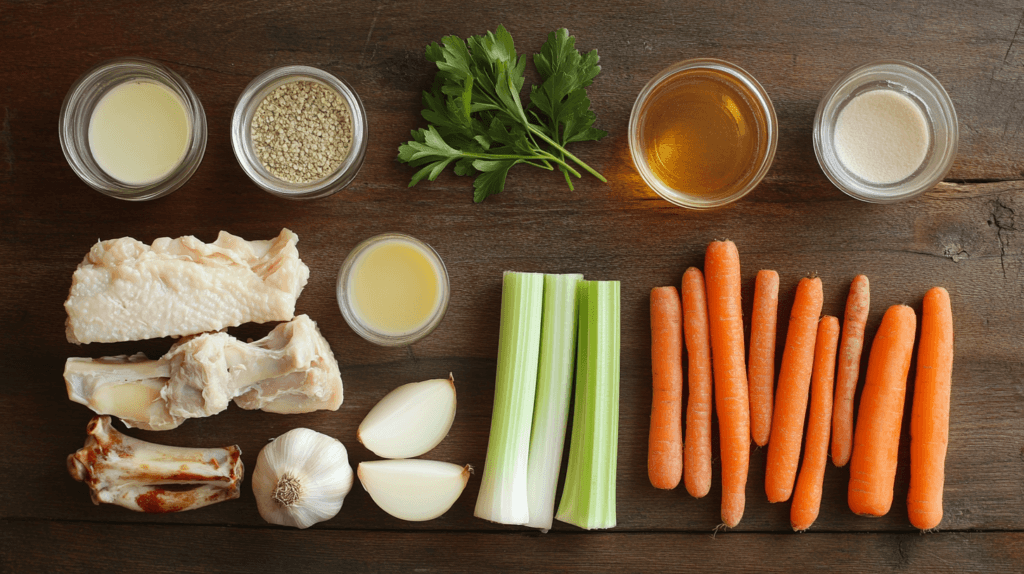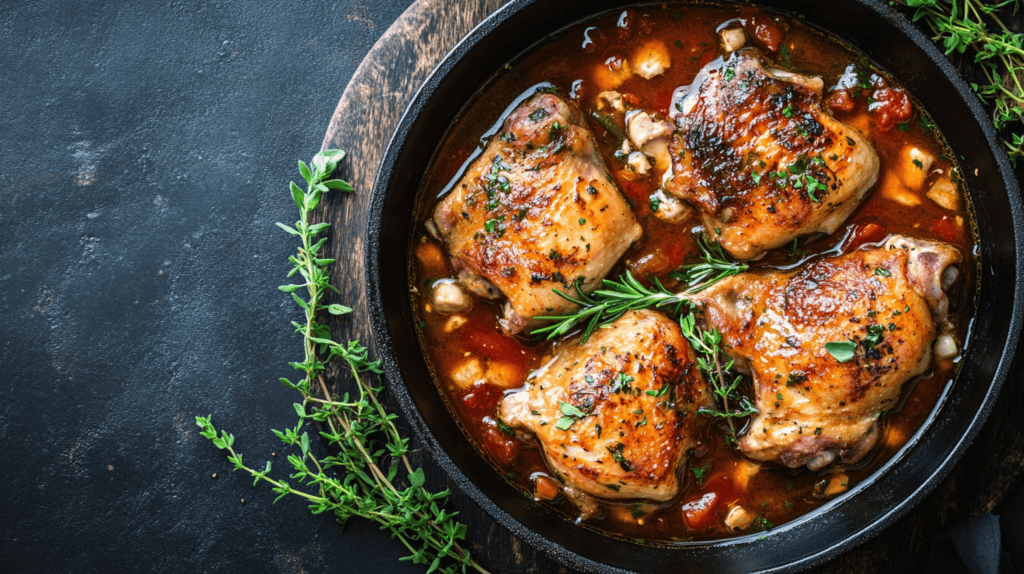Chicken bone broth is more than just a warm, savory liquid—it’s a powerhouse of nutrients with centuries of tradition behind it. Known for its soothing properties and versatile uses, a chicken bone broth recipe is a staple in kitchens worldwide. Whether you’re sipping it as a comforting beverage, using it as a base for soups, or incorporating it into your favorite recipes, homemade chicken bone broth is a game-changer.
Why should you make chicken bone broth at home? It’s all about control. By crafting your own broth, you can choose high-quality ingredients, avoid preservatives, and tweak the flavor to your liking. Plus, the process is easier than you might think, and the rewards include improved health, cost savings, and the satisfaction of reducing food waste.
Benefits of Chicken Bone Broth
Chicken bone broth offers numerous health benefits, making it a favorite among nutrition enthusiasts. It’s rich in collagen, amino acids, and minerals, supporting gut health, boosting the immune system, and promoting healthier skin, hair, and joints. Additionally, the broth’s versatility makes it a valuable addition to any meal plan, whether you’re cooking for health, taste, or convenience.
Table of Contents
Ingredients Overview

To make a perfect chicken bone broth, you’ll need a well-thought-out chicken bone broth recipe that combines basic ingredients with optional add-ins to enhance both flavor and nutrition.
Key Ingredients for a Chicken Bone Broth Recipe
- Chicken Bones: The star of the broth. You can use a combination of raw, roasted, or leftover bones from a cooked chicken. Aim for a mix of marrow bones, wings, and feet for the best nutrient extraction.
- Water: Use filtered water to ensure purity and avoid impurities that may alter the flavor.
- Apple Cider Vinegar: This is a critical ingredient that helps draw out the minerals and nutrients from the bones.
- Vegetables: Common choices include carrots, celery, onions, and garlic, which add depth and natural sweetness.
- Herbs and Spices: Bay leaves, thyme, parsley, and peppercorns provide aromatic richness.
Nutritional Profile of Chicken Bones in Your Recipe
Chicken bones are rich in calcium, magnesium, potassium, and other essential nutrients. When simmered for an extended period, the collagen and connective tissues break down, resulting in a gelatin-rich broth that’s excellent for gut health and joint support.
Optional Flavor Enhancers
- Ginger and Turmeric: Add anti-inflammatory properties and a unique flavor profile.
- Mushrooms: For an earthy depth of flavor.
- Seaweed: Kombu or wakame can boost the mineral content and umami taste.
Essential Equipment For Chicken Bone Broth Recipe
Before you start making chicken bone broth, following a proper chicken bone broth recipe and having the right tools on hand ensures a smoother cooking process and better results.
Stockpot vs. Slow Cooker vs. Instant Pot
- Stockpot: A large stockpot is the traditional choice for making bone broth. It allows for a slow simmer over low heat, which is key for extracting nutrients. However, it requires monitoring to ensure the broth doesn’t boil too rapidly.
- Slow Cooker: Perfect for those who want a hands-off approach. Simply set it on low heat and let it cook for 12–24 hours without constant supervision.
- Instant Pot: If you’re short on time, an Instant Pot can produce a flavorful bone broth in just a few hours using high pressure. While faster, the depth of flavor might not be as pronounced as the slow cooker or stockpot method.
Tools for Straining and Storing Homemade Chicken Bone Broth
- Fine-Mesh Strainer: Essential for removing bones and impurities to achieve a clear broth.
- Cheesecloth: Useful for an extra-smooth texture, especially if you’re serving the broth as a beverage.
- Ladles: For scooping the broth without disturbing the settled sediment.
- Glass Jars or Containers: Ideal for storing broth. Ensure they are heat-safe for hot liquids.
- Silicone Ice Cube Trays: A handy way to freeze broth in smaller portions for later use.
Choosing the Right Chicken Bones recipe
The quality and type of bones you use will directly affect the flavor and nutritional profile of your broth. Here’s what to keep in mind when selecting chicken bones.
Best Types of Chicken Bones for Your Recipe
- Marrow Bones: These are rich in nutrients like iron and calcium, and they add body to the broth.
- Chicken Feet: Packed with collagen, they are a must for a gelatin-rich broth.
- Wings and Necks: High in connective tissue, which breaks down into beneficial gelatin during cooking.
- Carcass or Leftover Bones: Using the bones from a roasted or rotisserie chicken adds a smoky depth to the flavor.
How to Source Quality Chicken Bones for a Recipe
- Organic or Free-Range Chickens: These are less likely to contain harmful chemicals or antibiotics, ensuring a purer broth.
- Local Butcher Shops: Many butchers sell chicken bones at a low cost or even give them away for free.
- Farmers’ Markets: A great option for finding high-quality, pasture-raised chicken bones.
- Leftovers: Save bones from chicken dinners or meals in the freezer until you have enough for a batch of broth.
Tips for Using Leftover Chicken Bones in a Broth Recipe
- Rinse bones lightly to remove seasoning if using leftovers from cooked meals.
- Combine various bone types for a richer flavor and diverse nutrient profile.
- Avoid charred or overly burned bones, as they can give your broth a bitter taste.
Step-by-Step chicken bone broth Recipe

Now that you have your ingredients and equipment ready, it’s time to dive into the process of making a delicious chicken bone broth recipe that can be easily adapted to suit your cooking preferences.
Prepping the Bones for a Chicken Bone Broth Recipe
- Roast Raw Bones (Optional): Spread raw chicken bones on a baking sheet and roast at 400°F (200°C) for 20–30 minutes. This step enhances the flavor with a deeper, roasted profile.
- Wash and Trim: Rinse the bones under cold water to remove any impurities or blood. Trim off excess fat if needed.
Cooking Process for the Best Chicken Bone Broth
Stove Method
- Place bones in a stockpot and cover them with filtered water.
- Add 1–2 tablespoons of apple cider vinegar and let the mixture sit for 30 minutes to help extract minerals.
- Bring to a gentle boil, then reduce to a simmer. Skim off any foam or impurities that rise to the surface.
- Add vegetables, herbs, and spices. Simmer on low for 12–24 hours, adding water as needed to keep bones submerged.
Slow Cooker Method
- Place bones, water, and vinegar in the slow cooker. Let sit for 30 minutes before turning on the heat.
- Set to low and cook for 12–24 hours. Add vegetables and herbs halfway through if desired.
Instant Pot Method
- Add bones, water, and vinegar to the pot. Let it sit for 30 minutes before sealing.
- Cook on high pressure for 2–3 hours, followed by a natural release.
- Strain the broth and adjust seasonings as needed.
Timing and Safety Tips
- Simmer for at least 8 hours for a basic broth or up to 24 hours for maximum nutrient extraction.
- Keep the lid slightly ajar during cooking to allow steam to escape and concentrate the flavor.
- Always use clean utensils and strain the broth carefully to avoid bits of bone or sediment.
Flavor Variations
Customizing your chicken bone broth recipe with different flavors can elevate its taste and make it adaptable to suit your preferences or specific recipes. Here are some ideas to explore:
Adding Vegetables and Herbs to Chicken Bone Broth Recipe
- Classic Aromatics: Add carrots, celery, onions, and garlic for a well-rounded, slightly sweet flavor.
- Herbs: Bay leaves, parsley, thyme, and rosemary are excellent for enhancing aroma and depth.
- Tomatoes: For a subtle acidity and richer color, toss in a few tomato halves.
Spices to Enhance a Chicken Bone Broth Recipe
- Peppercorns: A few whole peppercorns add a mild kick without overpowering the broth.
- Turmeric and Ginger: These spices bring a warming, slightly spicy element while adding anti-inflammatory benefits.
- Cinnamon and Star Anise: For an exotic twist, particularly if the broth will be used in Asian-inspired dishes.
Regional Flavor Twists for Your Chicken Bone Broth
- Asian-Style Broth: Include lemongrass, ginger, garlic, and a dash of soy sauce or fish sauce for an umami-packed variation.
- Mediterranean Touch: Add oregano, thyme, and sun-dried tomatoes.
- Mexican-Inspired Broth: Use cilantro stems, jalapeños, and cumin seeds.
Storage and Shelf Life
Proper storage ensures your chicken bone broth stays fresh and safe to use for weeks or even months. Follow these guidelines for the best results.
How to Store Bone Broth
- Refrigeration: Transfer the strained broth into airtight glass jars or containers. Allow it to cool to room temperature before refrigerating.
- Freezing: Portion the broth into smaller servings using silicone ice cube trays or freezer-safe containers. This allows you to defrost only the amount you need.
Freezing Tips for Homemade Chicken Bone Broth
- Leave some space in the containers, as liquids expand when they freeze.
- Use resealable freezer bags laid flat for efficient storage and quicker thawing.
- Label containers with the date for easy tracking.
How Long Does It Last?
- Refrigerator: Fresh bone broth can last 5–7 days when stored properly.
- Freezer: Frozen broth can be stored for up to 6 months. For best flavor, use it within 3 months.
How to Use Chicken Bone Broth
Once you’ve made your delicious and nutrient-rich broth, the possibilities for its use are endless. Here are some ideas:
Culinary Uses
- Soups and Stews: Use as the foundation for hearty dishes such as chicken noodle soup or beef stew.
- Sauces and Gravies: Replace water or store-bought broth with your homemade version for richer sauces.
- Cooking Grains: Boil rice, quinoa, or couscous in bone broth to infuse them with extra flavor.
Drinking as a Health Tonic
- Heat a cup of bone broth, season with a pinch of salt, and enjoy it as a nourishing drink.
- Add a splash of lemon juice, a sprinkle of turmeric, or a dollop of miso for variety.
Incorporating into Recipes
- Use as a braising liquid for meats or vegetables.
- Substitute for water in mashed potatoes or risotto for a creamier texture.
Health Benefits of Chicken Bone Broth Recipe
The growing popularity of chicken bone broth recipe stems largely from its numerous health benefits. Let’s take a closer look:
Gut Health and Collagen
- Bone broth is packed with gelatin, which can help calm the digestive system and support gut health.
- Collagen, found abundantly in bone broth, promotes a healthy gut lining and aids digestion.
Immune Support
- Packed with amino acids and minerals, chicken bone broth can strengthen your immune system, particularly during cold and flu season.
- The warm liquid also helps hydrate the body and provides a natural decongestant effect.
Benefits for Skin, Hair, and Joints
- The collagen and amino acids in bone broth contribute to improved skin elasticity, stronger nails, and shinier hair.
- Regular consumption can help reduce joint pain and improve mobility by replenishing cartilage.
Common Mistakes to Avoid
Making chicken bone broth is straightforward, but there are some common pitfalls to watch out for. Avoiding these mistakes ensures your broth is both flavorful and nutrient-rich.
Overboiling
- Boiling bone broth at too high a temperature can make it cloudy and give it a bitter taste. Always keep it at a gentle simmer.
Using Low-Quality Bones
- The quality of the bones directly impacts the flavor and nutrition of your broth. Avoid bones from conventionally raised chickens, which may contain unwanted additives or hormones.
Not Skimming Impurities
- During the initial stages of simmering, foam and impurities often rise to the surface. Skimming this off ensures a cleaner and better-tasting broth.
Adding Salt Too Early
- Since broth reduces during cooking, adding salt at the start can lead to an overly salty final product. Always season after the cooking process.
Forgetting the Vinegar
- Vinegar is essential for extracting minerals and nutrients from the bones. Without it, the broth may be less nutritious.
Tips for Making the Best Broth RECIPE
Roast the Bones
Roasting bones before simmering enhances their flavor, giving your broth a richer and more robust taste.
Use Apple Cider Vinegar
Adding apple cider vinegar to the water before cooking is a crucial step for extracting minerals and nutrients from the bones.
Cook Low and Slow
The secret to a perfect bone broth is patience. Simmering over low heat for 12–24 hours allows flavors and nutrients to develop fully.
Don’t Forget the Vegetables
Even though bones are the star of the broth, vegetables like carrots, celery, and onions add sweetness and depth to the flavor.
Strain Thoroughly
Use a fine-mesh strainer or cheesecloth to remove any small bone fragments, ensuring a smooth and clear broth.
Environmental and Cost Benefits
Making chicken bone broth at home offers benefits that extend beyond flavor and nutrition.
Reducing Food Waste
- By using leftover chicken bones and vegetable scraps, you can reduce food waste while creating something valuable and delicious.
- This practice aligns with sustainable cooking, making the most of every ingredient.
Saving Money
- Store-bought broths can be expensive and often contain preservatives. Homemade bone broth is not only more economical but also healthier.
- Making large batches and freezing portions allows you to save time and resources in the long run.
FAQs About Chicken Bone Broth
Can I Reuse Bones for Another Batch?
Yes, you can reuse bones, but subsequent batches may be less flavorful and nutrient-dense. To maximize nutrients from reused bones, consider adding fresh vegetables and a splash of vinegar. If you’re looking for ways to incorporate reused bones, check out our rotisserie chicken recipes for more ideas on making the most of leftovers.
Is It Safe to Drink Bone Broth Daily?
Absolutely! Drinking a cup of bone broth daily can support gut health, skin elasticity, and joint health. If you’re considering daily consumption, you might also explore the health benefits of sinigang as another nutrient-packed soup option.
What’s the Difference Between Broth and Stock?
Bone broth is simmered for a much longer time than stock, allowing collagen and nutrients to fully break down into the liquid. Stock, on the other hand, is cooked for a shorter period and is typically less gelatinous.
Why Does My Broth Not Gel?
If your broth doesn’t gel, it might be due to insufficient collagen. Using connective tissues like chicken feet or wings and simmering longer can help. For more ideas on achieving the perfect texture, see our tips for cooking hot dogs on a Blackstone for temperature control techniques that might inspire you.
Can I Make Bone Broth Without a Slow Cooker or Instant Pot?
Yes! A simple stockpot on the stove works just as well. It requires more attention to maintain the right temperature but produces equally delicious results.
How Do I Make My Broth Clearer?
To achieve a clear broth, avoid stirring it while simmering, and strain it carefully using a fine-mesh strainer or cheesecloth.
Conclusion
Chicken bone broth is a versatile, nutrient-packed staple that’s easy to customize. Whether you’re sipping it warm or using it as a base for hearty recipes, the benefits of homemade broth are undeniable. Ready to dive deeper into culinary adventures? Explore recipes like our ultimate guide to Rotel dip or learn how to store balsamic vinegar properly.

Chicken Bone Broth Recipe: The Ultimate Guide
Ingredients
- Main Ingredients
- 2-3 lbs chicken bones carcass, wings, necks, or feet
- 10 cups water
- 2 tablespoons apple cider vinegar helps extract nutrients from bones
- Vegetables & Aromatics
- 1 large onion quartered
- 2 carrots chopped
- 2 celery stalks chopped
- 4 garlic cloves smashed
- 1 teaspoon black peppercorns
- 1-2 bay leaves
- A handful of fresh parsley optional
- 1 teaspoon salt adjust to taste
Instructions
- Prepare the BonesRinse the chicken bones under cold water and place them in a large stockpot or slow cooker.
- Add Ingredients & SimmerPour water over the bones, add apple cider vinegar, vegetables, herbs, and spices. Bring to a boil, then reduce heat to low and let it simmer for 12-24 hours.
- Skim ImpuritiesOccasionally skim off any foam or impurities that rise to the surface during simmering.
- Strain the BrothRemove large bones and vegetables, then strain the broth through a fine-mesh sieve.
- Cool & StoreLet the broth cool before storing it in airtight containers. Refrigerate for up to 5 days, or freeze for 3-6 months.
Notes
- Use organic bones for a cleaner and more nutritious broth.
- Roasting the bones before simmering enhances the flavor.
- Add turmeric or ginger for extra anti-inflammatory benefits.
- If using a pressure cooker (Instant Pot), cook on high for 2 hours instead of simmering for 12-24 hours.

